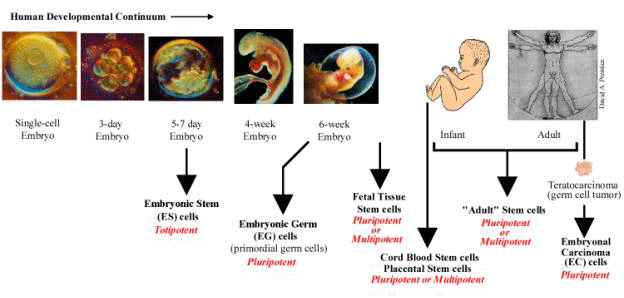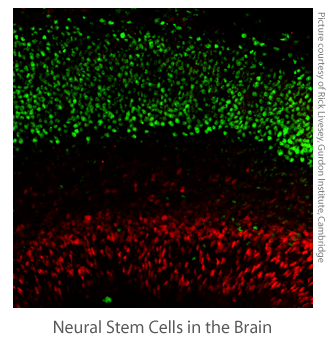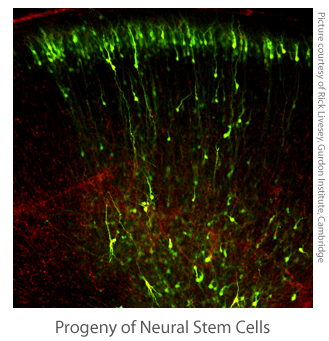

Stem cells are the 'founder' cells from which all the specialized cells forming the organs and tissues in your body come from. There are 2 types, embryonic and adult.
 Embryonic Stem (ES) cells come from mammalian embryos about 5 days after fertilisation. These cells can differentiate into all the specialised types of cells the body needs, eg neurons, heart cells and muscle cells (i.e. they are 'pluripotent'). Adult stem cells (somatic stem cells) are found in tissues such as brain, bone marrow, skin, skeletal muscle and liver where they are used to replace lost or damaged cells from that specific tissue. For example, a blood-forming (haematopoetic) adult stem cell in the bone marrow normally generates blood cells such as platelets, red blood cells, and white blood cells. Bone marrow transplants, containing blood-forming stem cells have been carried out for over 30 years. |
 |
Neural Stem Cells
Neural stem cells are the cells that make all of the neurons and their supporting cells in the brain during development and, in some animals, replace lost neurons throughout life. Neural stem cells divide every 24 hours and decide what kind of cells (more stem cells or different kinds of nerve cells) their daughter cells are going to be - the daughters have little say in it. If the decisions the stem cells make during embryonic development go awry it leads to childhood disorders ranging from epilepsy, learning disabilities to autism. Adult humans don't have many neural stem cells in their brains, and the ones we have are not very efficient at repairing damage. This is why there is a lot of effort going into either trying to stimulate the stem cells we have to repair brain injuries or lost neurons (from Alzhemier's disease or Motor Neuron disease, for example) and also in making lots of neural stem cells in the lab so they and the nerve cells they make can be transplanted into patients. Therapeutic importance - why are we interested in stem cells?Stem cells can also be used to study how human bodies develop, and to study cancer but future technology could use stem cells to grow new organs, replace diseased cells and cure many illnesses. This may herald a new day for organ transplantation as the rejection of foreign objects (for example, another person's heart) by the immune system will not be an issue, as the cells will have the same genetic make-up as the patient. But there are many scientific and ethical hurdles to overcome before most treatments become viable. Can we really cure diseases such as Parkinson's disease, heart disease and diabetes using stem cells? It is at least theoretically possible to replace the defective cells in each of these conditions with cells derived from the same person's stem cells. Stem cells used in skin grafts: MyskinTM is a product for treating burns, ulcers and non-healing wounds which takes adult epithelial stem cells from the patient, cultures them in a specific way, and produces new skin cells to aid healing. |
 |
Another way to generate stem cells with no risk of rejection is by cell nuclear replacement (often called therapeutic cloning) This uses cloning technology to remove the DNA from a human oocyte (egg), and replace this with the DNA of the patient. The egg is induced to develop and the resulting embryo is then used to make stem cells, which will have the same DNA as the patient. This is different from reproductive cloning (such as was used to create Dolly the sheep), as the embryo will not be implanted into a uterus. (Picture of injected egg)
Is it ethical to create embryos for research by cell nuclear replacement? Is this a slippery slope leading to reproductive cloning (cloning ourselves)? Human embryonic stem cells are isolated from human embryos created through in-vitro fertilization (IVF) at a clinic, and donated with consent for research. They are 'destroyed' after the process. These are embryos that if implanted into a woman's uterus, would have had the chance of life. Is it ethical to use these discarded embryos? Or would it be wasteful not to?
If the aim is the relief of human suffering from disease, does the end justify the means? How should we act towards human embryos? Would it make a difference to your view if someone you loved was suffering from e.g. Parkinson's disease, and there was the possibility that stem cell research could cure them?.
Current UK policy is that an embryo doesn't have the full legal rights of a person, but that we should respect embryos. In 2001, the Human Fertilisation and Embryology Act permitted embryo research that is 'necessary or desirable' for understanding embryos or understanding or treating serious disease. The creation of embryos for research is legal. Nuclear cell replacement (therapeutic cloning) is also legal, but reproductive cloning where the cloned embryo is implanted in a woman's uterus is absolutely banned.
This is not the easiest subject to depict artistically but here are some ideas:
Depict the pluripotent nature of stem cells
Look at how stem cells may be used in the future... especially in brain therapy
Explore how stem cells can take on different characteristics depending on the environment
For further details of how to participate in this annual competition see 2007 Home Page
Back to 'Imagining The Brain' Home Page
Background to project
Back to McMahon Home Page